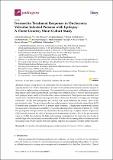Ivermectin Treatment Response in Onchocerca Volvulus Infected Persons with Epilepsy: A Three-Country Short Cohort Study
View/
Publication Date
2020-07-29Type
Article, Journalviews
downloads
Metadata
Show full item recordCitation
Dusabimana A, Bhwana D, Raimon S, Mmbando BP, Hotterbeekx A, Tepage F, Mandro M, Siewe Fodjo JN, Abrams S, Colebunders R. Ivermectin Treatment Response in Onchocerca Volvulus Infected Persons with Epilepsy: A Three-Country Short Cohort Study. Pathogens. 2020 Jul 29;9(8):617. doi: 10.3390/pathogens9080617. PMID: 32751060; PMCID: PMC7460326.
Abstract/
Despite a long history of community-directed treatment with ivermectin (CDTI), a high ongoing Onchocerca volvulus transmission is observed in certain onchocerciasis-endemic regions in Africa with a high prevalence of epilepsy. We investigated factors associated with higher microfilarial (mf) density after ivermectin treatment. Skin snips were obtained from O. volvulus-infected persons with epilepsy before, and 3 to 5 months after ivermectin treatment. Participants were enrolled from 4 study sites: Maridi (South Sudan); Logo and Aketi (Democratic Republic of Congo); and Mahenge (Tanzania). Of the 329 participants, 105 (31.9%) had a post-treatment mf density >20% of the pre-treatment value. The percentage reduction in the geometric mean mf density ranged from 69.0% (5 months after treatment) to 89.4% (3 months after treatment). A higher pre-treatment mf density was associated with increased probability of a positive skin snip after ivermectin treatment (p = 0.016). For participants with persistent microfiladermia during follow-up, a higher number of previous CDTI rounds increased the odds of having a post-treatment mf density >20% of the pre-treatment value (p = 0.006). In conclusion, the high onchocerciasis transmission in the study sites may be due to initially high infection intensity in some individuals. Whether the decreasing effect of ivermectin with increasing years of CDTI results from sub-optimal response mechanisms warrants further research.
Publisher
MDPICollections
- General - GEN [367]

